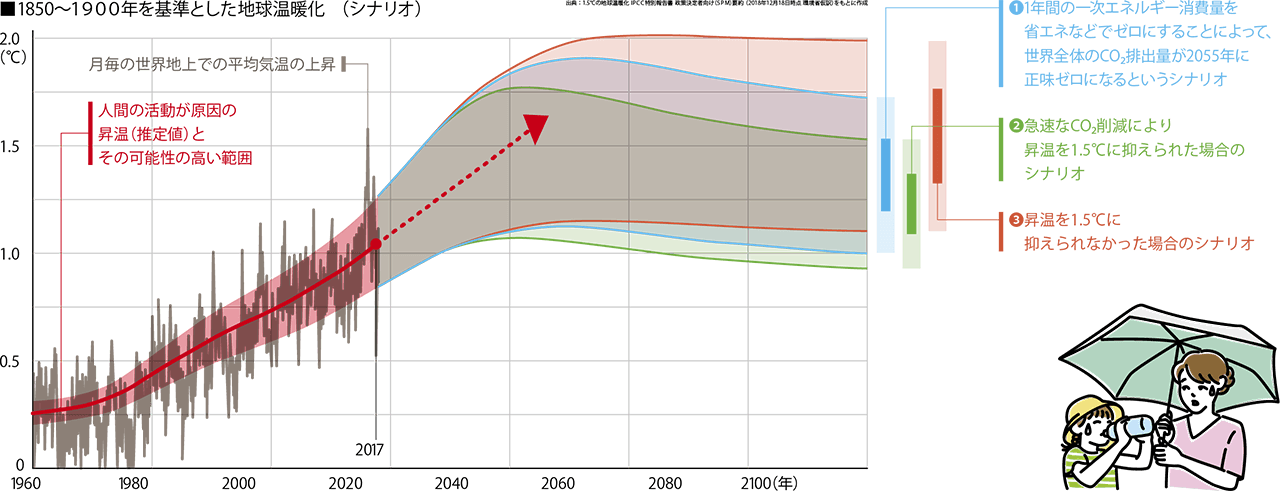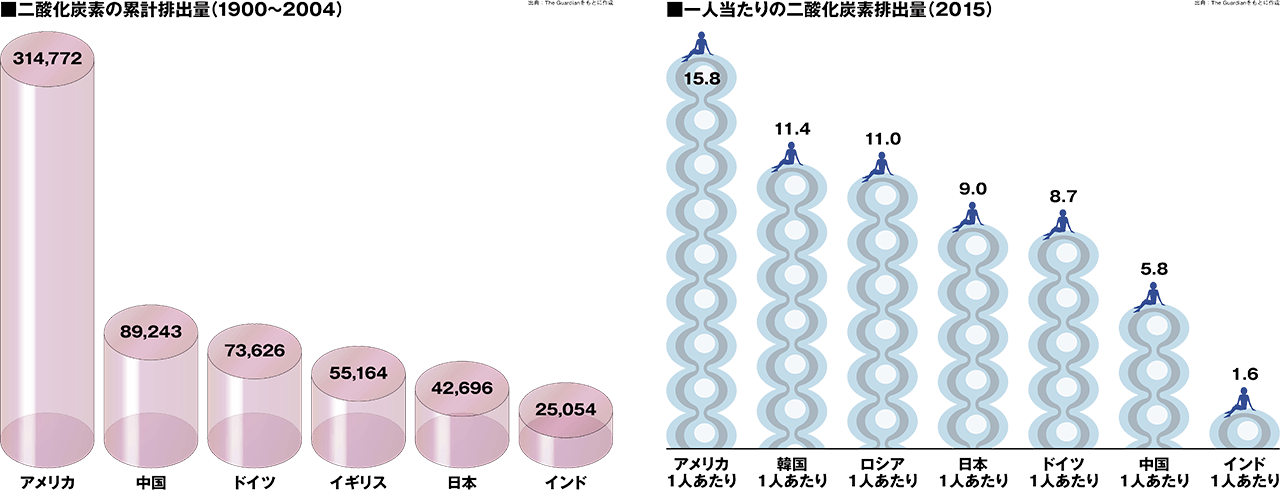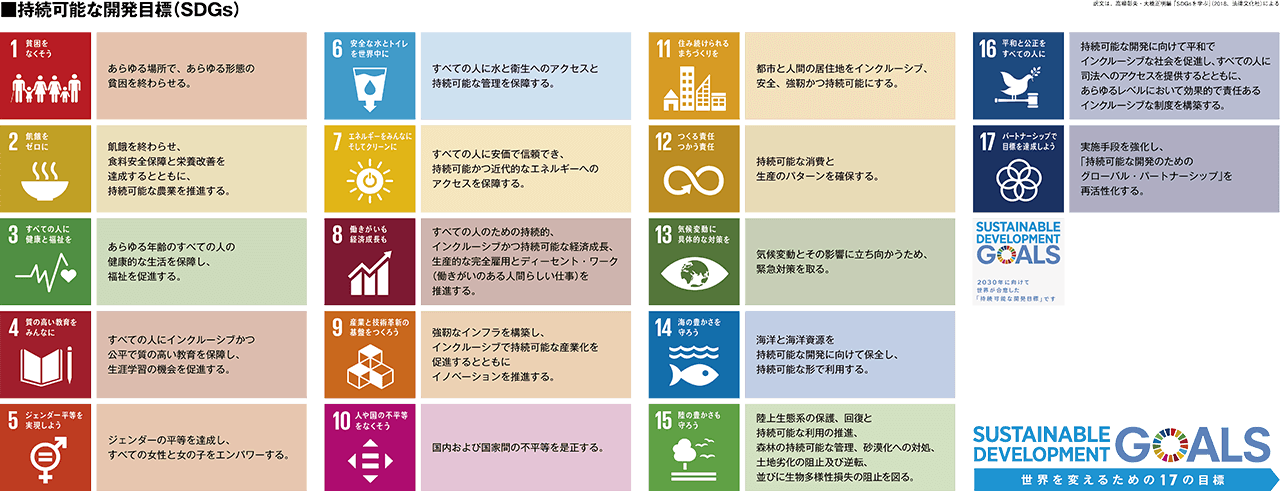いま何が起きているの?
何が起きているの?
What is happening?
私たちが暮らす日本も地球も平均気温が年々高くなってきています。下のグラフを見てわかる通り、一時的に気温が下がったとしても、長期的に見れば上昇しているのです。 2016年はこの130年間で最も平均気温が高い年でした。また、2018年は、6~8月の東日本の平均気温が統計開始以来もっとも高くなるなど、全国各地で最高気温が更新されました。埼玉県熊谷市では過去最高の41.1度を記録するなど、日本列島が猛暑に見舞われたことは記憶に新しい人も多いでしょう。地球は温暖化していると言われており、このまま気温が上がり続けると、台風が大型になったり、動植物が絶滅したり、食料不足になったり、疫病が流行ったりすることが懸念されています。
下の図には、どの位CO₂を減らせるかによって変わる地上の平均気温の上昇に関する3つのシナリオが描かれています。これらを左右するのは現代社会を生きる私たちの生活や発展のあり方であるといえます。
温暖化の1番の原因は何だと思いますか。
The average temperature in Japan and much of the rest of the world has increased every year.
As the graph below presents, the average temperature has increased over the long-term, even
though it has temporally decreased. The average global temperature in 2016 was the highest
recorded temperature in 130 years. Also, in 2018, the maximum temperature all around Japan
was higher than in the past. The average temperature from June to August in East Japan was
the highest on record since statistics were kept. We may remember that the recorded maximum
temperature of 41.1°C in Kumagaya, Saitama prefecture was broken.
Global warming is serious. If the temperature keeps rising, stronger typhoons, mass extinction,
food insecurity and infectious diseases are predicted.
The chart below illustrates three types of scenarios relating to the average rise in surface temperature, dependent upon how much we can reduce CO₂ emissions. Each scenario is largely affected by our current everyday living and developments in our modernized society.
What is the biggest reason for global warming?

どうして起きているの?
Why does global warming occur?
私たちの暮らす地球の大気には「温室効果ガス」が含まれていて、地球のまわりをグリーンハウス(温室)のように取り囲み、全体の熱を逃がさなくしています。このおかげで気温は地球上の生き物にとって適度に保たれてきたのです。ところが、18世紀半ば以後に起きた産業革命以後、豊かさを求める生活を人間が続けた結果、温室効果ガスが大気中で増えすぎてしまいました。温室効果ガスには、二酸化炭素(CO₂)の他、メタンや亜酸化窒素、対流圏のオゾン、フロンなどが含まれますが、中でも二酸化炭素の影響がとても大きく、懸念されています。
あなたの生活で二酸化炭素を過剰に出しているのはどのような場面でしょう。
Certain gases in the atmosphere which are called greenhouse gases surround the earth to trap heat. This has maintained a comfortable temperature for living things over a long period of time. However, greenhouse gasses have increased rapidly since the industrial revolution beginning from the 18th century. Greenhouse gases include not only carbon dioxide (CO₂), but also methane, nitrous oxide, ozone and freon in the troposphere. Especially CO₂ powerfully influences global warming.
When do you think you emit too much CO₂ in your daily life?

…だれが起こしたの?
Who caused global warming?
二酸化炭素の排出は、産業革命以降に急増しました。下の左図「二酸化炭素の累計排出量」では二番目に位置している中国ですが、右図「一人当たりの二酸化炭素排出量」でみると、アメリカ、韓国、ロシア、日本、ドイツの順で責任が重く見えます。
地球温暖化の問題解決は共通の責任であるが、先進国とこれから発展する途上国には責任の重さに違いがあるという「共通だが差異ある責任(Common But Differentiated Responsibilities=CBDR)」という考え方が、1990年代にでてきました。先進国が率先して温室効果ガスの削減を行うほか、途上国に温暖化対策のための資金や技術を提供することが求められています。
By the way, CO₂ emissions rapidly increased after the industrial revolution, and many highly industrialized countries today owe their development to the industrial revolution. Although CO₂ emissions in China are now the second highest in the world, as shown in the chart to the right, emissions per capita are considerably less than Germany and Japan, as well as the United States, Russia and South Korea. In this regard, responsibilities of western countries seem more grave.
Following this situation, the principle of Common But Differentiated Responsibilities (CBDR) has been discussed as an international agenda since the 1990s. This means that all countries are responsible for solving global warming; however, their responsibilities are not equal because of the differences in levels of economic development. Developed countries are required to take the initiative in reducing greenhouse gases and provide funds and technology for addressing global warming in developing countries.

環境後進国になりつつある日本
Japan Becoming an Environmentally Developing Nation
環境先進国や環境技術立国という言葉は聞きなれた表現かもしれません。たしかにかつての日本はこうした表現に相応しい頑張りようが見られたのかもしれません。しかし、今、国際的なデータを見ると、いつの間にかこれらの言葉にあぐらをかいて温暖化対策などにおいて「環境後進国」となりつつある日本の姿が浮き彫りになります。次に示すのは、ドイツの環境NGO団体German Watchが57ヵ国を比べた国際比較の結果です。
これらは政策関連のデータですが、2018年度の国連環境計画の報告書によれば、1人あたりの使い捨てプラスチックごみの発生量は、日本は1人あたり年間32キログラムであり、全世界で第2位という不名誉な順位です※。さて、このような現況の中、私たちに何ができるのでしょう。
You may already be familiar with the terms, “environmentally advanced nation” or “environmental technology-oriented nation.” It is true that Japan was once a country making efforts in line with such terms. However as of present, when looking at the global data, Japan has become an environmentally developing nation in taking effective measures to tackle global warming. The following chart is taken from an environmental NGO in Germany named the “German Watch” comparing the efforts taken by 57 countries to manage global warming, greenhouse gas and reusable energy. According to this data, Japan stands 44th, 47th and 48th respectively in its international comparison.
This data is more policy oriented, yet according to the report of the United Nations Environment Programme (UNEP) presented in 2018, the amount of plastic garbage disposed per person annually in Japan is 32 kilograms. This amount places Japan in second place globally in terms of plastic waste disposal. This is unacceptable. What can we do about this situation?

気候変動とSDGsの関係って?
How is climate change linked with the Sustainable Development Goals?
2015年9月の国連総会において世界の共通目標とも言える17の「持続可能な開発目標(SDGs)」が「だれ一人取り残さない」という基本理念の下に全会一致で採択されました。
17の目標の13番目は「気候変動」です。この目標を達成するための具体的なターゲットと実施手段、さらには各項目の達成について確認をするための指標が掲げられています(表参照)。
SDGsの特徴は、17の目標それぞれが相互に関連性をもっているということです。温暖化のために作物が収穫できずに貧困や飢え(目標1及び2)が深刻化したり、移住を強いられて学校教育(目標4)が受けられなくなったり、干ばつが起こり安全な水(目標6)が確保できなくなったりすることが一例です。特に気候変動は関わりのない目標を見つけるのが困難なほどに重要なテーマであると言えましょう。
上記の他にも地球規模で温暖化が進むとSDGsの中のどの目標(分野)が影響を被るのか、具体的な事例をあげてみましょう。
In September 2015, the UN general assembly adopted consensus on the 17 Sustainable Development Goals, which are common global goals framed under the fundamental principle of “No one left behind.”
Goal 13 is specific to climate change. Each goal specifies targets, measures and indicators. The biggest feature of the SDGs is that the 17 goals are mutually interrelated. Global warming has major impacts on other goals making it a critical issue for all. For instance, poverty and hunger (Goal 1 and 2) will become more acute if people cannot harvest crops. Also, children will be at high risk of being denied access to education (Goal 4) if they are forced to migrate. We will also experience a lack of clean water (Goal 6) due to drought. These are just some examples.
Can you think of more examples of specific cases caused by global warming?
Which SDG goals are linked with those cases?

アンケート
アンケートへのご協力をお願いいたします。